25 September 2016
The Roaming Chocoholic has arrived in the birth city of VOLVO – Gothenburg, Sweden. In no time at all, my Swedish colleague sets me off on yet another adventure by introducing me to the concept “fika”. Apparently, in the Swedish office in Gothenburg, everyone stops work and sits down for a “fika” at least once a week. Wow!
By definition, “fika” means “to have coffee”, usually accompanied by a sweet (or savoury) treat. And “fika” is ingrained in Swedish culture; almost sacred. Seeing that it’s so important, what do the Swedish do for sweets and more importantly, how do they eat their chocolates? Here’s a rundown of what I’ve discovered.
Goteborgspralinen
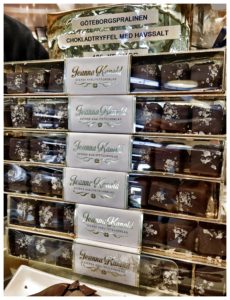 When in Gothenburg, do seek out Flikorna Kanold to savour Jeanna’s Goteborgspralinen or Gothenburg praline.
When in Gothenburg, do seek out Flikorna Kanold to savour Jeanna’s Goteborgspralinen or Gothenburg praline.
It’s dark chocolate ganache, covered in dark chocolate, with sprinkles of salt flakes on top. Perhaps hard to imagine how a few flakes of salt can elevate the taste experience, but it just does. The sweet and salty combination dances around in my mouth, as the smooth and rich ganache melts away. After your first, you’ll probably want more – which is why Jeanna sells them in boxes of 4s and 8s too.
As an accomplished chocolatier and businessperson, Jeanna is still going from strength to strength almost 20 years since she started handcrafting her chocolates in the basement of her original store in Victoria passagen (passage). Her mini empire has now expanded to include a store in Salunhallen (Market hall) and a cafe, all within a stone’s throw of each other.
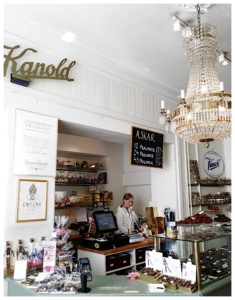
Adelost
If you have an affinity towards blue cheese, then the adelost is for you. It’s Swedish blue cheese at its best. And at Flikorna Kanold, Jeanna has taken it one step further by incoporating it into dark chocolate ganache, and enrobing the ganache in dark chocolate.
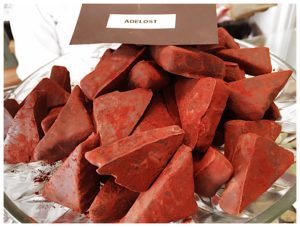 The strong and savoury adelost, coupled with the mildly sweet and ever so slight bitterness of the dark chocolate, is a match made in heaven.
The strong and savoury adelost, coupled with the mildly sweet and ever so slight bitterness of the dark chocolate, is a match made in heaven.
For the cheese and chocolate lovers amongst us, Jeanna also does a good goat’s cheese and honey dark chocolate ganache. Just a word of caution to the less inclined – the goat’s cheese is fairly strong!
Dammsugare
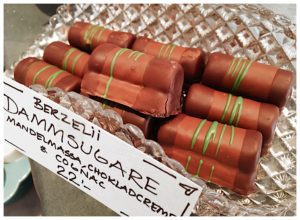 Translated into English, it simply means vacuum cleaner. However, to the locals, the word dammsugare (also known as the punschrulle or punsch roll) is fondly associated with a quintessential Swedish treat.
Translated into English, it simply means vacuum cleaner. However, to the locals, the word dammsugare (also known as the punschrulle or punsch roll) is fondly associated with a quintessential Swedish treat.
The traditional dammsugare comprises a mixture of crushed cookies, butter and cocoa, flavoured with a dash of punsch liqueur, then rolled in a layer of marzipan to form logs. To finish off, the ends are dipped in chocolate.
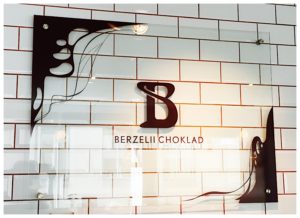 At Berzelii Choklad, this is just one of many chocolate treats that await you….provided you can find the shop. It’s tucked away on the first floor of a homewares’ shop, just a short stroll from Victoriapassagen.
At Berzelii Choklad, this is just one of many chocolate treats that await you….provided you can find the shop. It’s tucked away on the first floor of a homewares’ shop, just a short stroll from Victoriapassagen.
Lingonberries
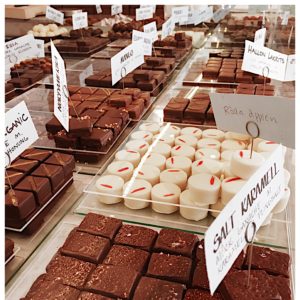 These are small and tart red berries, native to and found in abundance in Sweden and other Nordic countries. For a Swedish experience, try the lingonberry in dark chocolate ganache at Berzelii Choklad. The tartness of the lingonberry pairs surprisingly well with the bitter sweet dark chocolate ganache, creating the perfect balance of tastes.
These are small and tart red berries, native to and found in abundance in Sweden and other Nordic countries. For a Swedish experience, try the lingonberry in dark chocolate ganache at Berzelii Choklad. The tartness of the lingonberry pairs surprisingly well with the bitter sweet dark chocolate ganache, creating the perfect balance of tastes.
Berzelii’s blackberry dark chocolate ganache is also worthy of a go, with its intense berry flavour, as is their version of the salted caramel ganache, dark caramel ganache flavoured with a triangle of maldon salt.
Chokladbiskvi
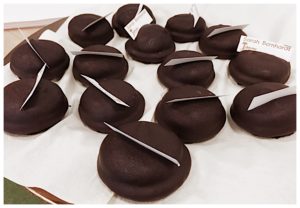 The chocolate biscuit, more popularly known as the Sarah Bernhardt, is yet another favourite treat that I’ve discovered. Named after the famous French actress of the 19th and early 20th century, Sarah apparently fell head over heels for this sweet treat while on a visit to Denmark. It was subsequently named after her. The Swedish too have developed a fondness for it and named it their chokladbiskvi (chocolate biscuit in Swedish).
The chocolate biscuit, more popularly known as the Sarah Bernhardt, is yet another favourite treat that I’ve discovered. Named after the famous French actress of the 19th and early 20th century, Sarah apparently fell head over heels for this sweet treat while on a visit to Denmark. It was subsequently named after her. The Swedish too have developed a fondness for it and named it their chokladbiskvi (chocolate biscuit in Swedish).
The base, made of chewy almond macaron or meringue, is topped with rich chocolate butter cream. The combination is then dipped or enrobed in dark chocolate. Such sweet decadence. It’s no wonder Sarah was smitten from her first bite.
Daim
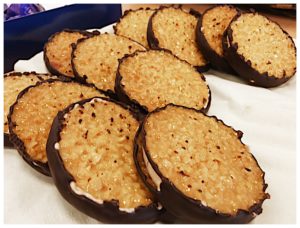 Daim is to the Swedish (and Nordics in general) what Hershey’s is to the Americans. You can find it at any supermarket and convenience store, at every train station and even at the airport. It’s crunchy almond brittle, coated in milk chocolate.
Daim is to the Swedish (and Nordics in general) what Hershey’s is to the Americans. You can find it at any supermarket and convenience store, at every train station and even at the airport. It’s crunchy almond brittle, coated in milk chocolate.
I had the pleasure of tasting what I would regard as the ultimate Daim treat, during morning tea at our Swedish office. Whipped cream sandwiched between two generous circular discs of crunchy almond brittle, the ends then dipped in dark chocolate. It’s the ultimate sugar fix for the mid afternoon slump. And if anyone knows what this is called in Swedish, please do let me know!
Suffice to say, based on my discoveries, the Swedish take their sweets and chocolates seriously too. So don’t underestimate the skills and creativity of Swedish chocolatiers and pattisiers. Seek these decadent Swedish sweet treats out and decide for yourself!
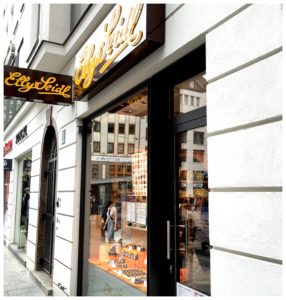 If you prefer to eat your alcohol, infused in chocolate truffles, look no further than
If you prefer to eat your alcohol, infused in chocolate truffles, look no further than 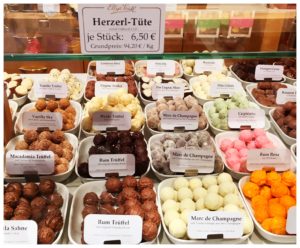 My top picks are the feminine pink Elly, a white chocolate heart with a pink centre, filled with raspberry liquor flavoured butter cream, and the Arrak teesahne, a crisp dark chocolate filled with Ceylon tea infused cream and flavoured with Arrak (Asian liquor made from fermented rice or palm syrup).
My top picks are the feminine pink Elly, a white chocolate heart with a pink centre, filled with raspberry liquor flavoured butter cream, and the Arrak teesahne, a crisp dark chocolate filled with Ceylon tea infused cream and flavoured with Arrak (Asian liquor made from fermented rice or palm syrup).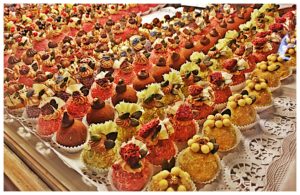 Fancy eating traditional treats of marzipan and nougat, turned into beautiful pieces of art that are lovingly handcrafted by its creator? Visit
Fancy eating traditional treats of marzipan and nougat, turned into beautiful pieces of art that are lovingly handcrafted by its creator? Visit 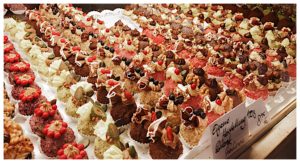 If you time your visit perfectly, you may catch Wilhelmine in action creating and decorating her marzipan and nougat masterpieces. There are apparently well over 100 variants, including the King Ludwig, the Venus Nipple, and the Hot, Chilli Seduction.
If you time your visit perfectly, you may catch Wilhelmine in action creating and decorating her marzipan and nougat masterpieces. There are apparently well over 100 variants, including the King Ludwig, the Venus Nipple, and the Hot, Chilli Seduction.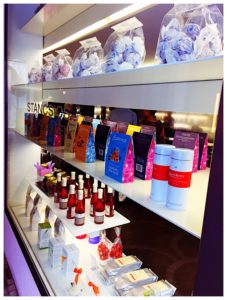 Fitting perfectly into its location, close to the glitzy shopping strip of Maximilianstrasse, is
Fitting perfectly into its location, close to the glitzy shopping strip of Maximilianstrasse, is 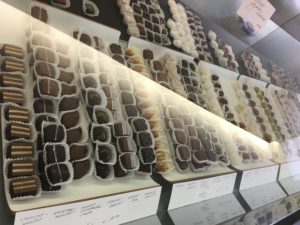 According to owner Silvia Stancsics, the main inspiration for her flavour creations comes from local and seasonal ingredients. Of course, meeting the taste preferences of her regular clientele is also important, which is why the variety spans alcoholic and non-alcoholic offerings. And with no added preservatives, the chocolates should be consumed within 6 to 8 days. You can also find offerings from other European chocolate makers here including the reputed Italian Domori, Austrian Tiroler Edle, Danish Summerbird and French Mademoiselle de Margaux.
According to owner Silvia Stancsics, the main inspiration for her flavour creations comes from local and seasonal ingredients. Of course, meeting the taste preferences of her regular clientele is also important, which is why the variety spans alcoholic and non-alcoholic offerings. And with no added preservatives, the chocolates should be consumed within 6 to 8 days. You can also find offerings from other European chocolate makers here including the reputed Italian Domori, Austrian Tiroler Edle, Danish Summerbird and French Mademoiselle de Margaux.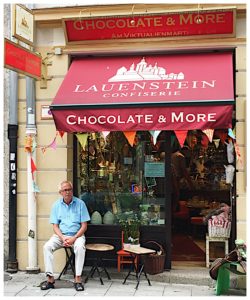 Christine Luger is an interior designer by trade, with a consuming passion for all things chocolate. It’s no surprise that she runs the hippy and inviting
Christine Luger is an interior designer by trade, with a consuming passion for all things chocolate. It’s no surprise that she runs the hippy and inviting 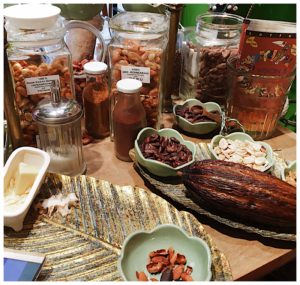 Christine is a strong advocate of the health promoting properties of raw cocoa beans. She tells me that consuming 3 whole beans a day is sufficient to meet our dietary intake of antioxidants, and offers me a tasting. I oblige and pop a raw Peruvian cacao bean into my mouth. It’s strong, nutty and definitely tastes like chocolate. Much better than medicine, to keep the lurgies at bay?
Christine is a strong advocate of the health promoting properties of raw cocoa beans. She tells me that consuming 3 whole beans a day is sufficient to meet our dietary intake of antioxidants, and offers me a tasting. I oblige and pop a raw Peruvian cacao bean into my mouth. It’s strong, nutty and definitely tastes like chocolate. Much better than medicine, to keep the lurgies at bay?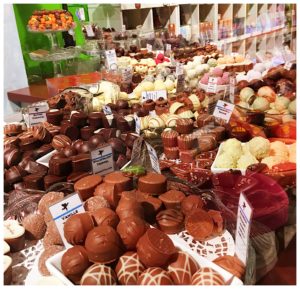 For those more inclined towards the chocolates, there’s a wide selection of truffles, pralines, ganaches, marzipans and bars from the northern Bavarian chocolate maker, Lauenstein. There are also chocolates and related products from neighboring countries such as France, Belgium and the UK. And the cafe specialises in hot chocolate, with contemporary concoctions like chilli and black pepper hot chocolate.
For those more inclined towards the chocolates, there’s a wide selection of truffles, pralines, ganaches, marzipans and bars from the northern Bavarian chocolate maker, Lauenstein. There are also chocolates and related products from neighboring countries such as France, Belgium and the UK. And the cafe specialises in hot chocolate, with contemporary concoctions like chilli and black pepper hot chocolate.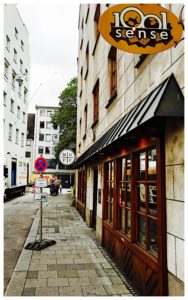 A global library of chocolates is how I can best describe
A global library of chocolates is how I can best describe 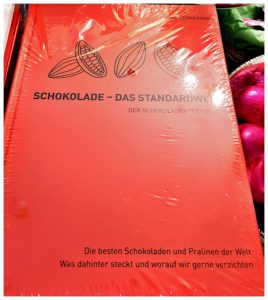 Inna recommends that I get myself a copy of the modern day chocolate encyclopaedia/ text book “Schokolade – Das Standardwerk: Der Schokoladetester 2015” (translates into Chocolate – The Standard Works: The Chocolate Tester 2015), by Georg Bernardini. Mental note to self………
Inna recommends that I get myself a copy of the modern day chocolate encyclopaedia/ text book “Schokolade – Das Standardwerk: Der Schokoladetester 2015” (translates into Chocolate – The Standard Works: The Chocolate Tester 2015), by Georg Bernardini. Mental note to self………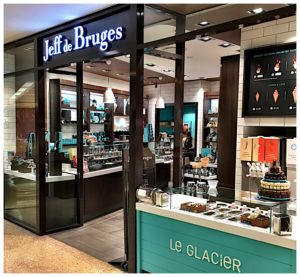 My first observation, as I approach the shop, is the decor. It’s fairly consistent around the world. For a moment, I forget where I am and imagine walking down a cobblestone street of a cosmopolitan European city, lapping up the late summer sun.
My first observation, as I approach the shop, is the decor. It’s fairly consistent around the world. For a moment, I forget where I am and imagine walking down a cobblestone street of a cosmopolitan European city, lapping up the late summer sun.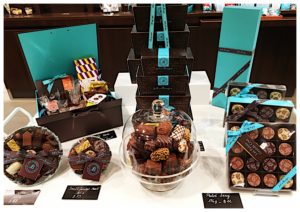 A lovely young lady welcomes me and asks if she can assist.
A lovely young lady welcomes me and asks if she can assist.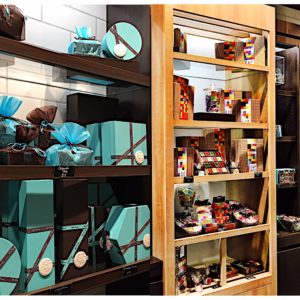 The shelves are adorned with attractive boxes of filled chocolates, as well as single origin bars and chocolate squares. No detail is spared with design and branding. The pocket sized catalogue of their filled chocolates and Juliettes (a version of the mendiant) is both a nice touch and handy to have, as I work my way through their selections.
The shelves are adorned with attractive boxes of filled chocolates, as well as single origin bars and chocolate squares. No detail is spared with design and branding. The pocket sized catalogue of their filled chocolates and Juliettes (a version of the mendiant) is both a nice touch and handy to have, as I work my way through their selections.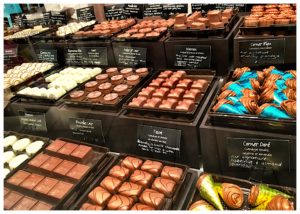 I’m offered a tasting of filled chocolates and pick the Maison de Jeff dark 70%. It’s a house-shaped dark chocolate praline with bits of almonds, and hints of cinnamon and coriander. The cinnamon is predictable in the combination and marries well with the dark chocolate and praline, but the coriander doesn’t come through for me. I find the Tarte Citron more exciting. The lemon is refreshing and balances both the sweetness and richness of the ganache, enveloped in dark chocolate. The Harvey is a play on textures, with an almost molten, creamy praline accented with bits of biscuit, in a dark chocolate shell shaped like a Scottish terrier. Almost too cute to eat.
I’m offered a tasting of filled chocolates and pick the Maison de Jeff dark 70%. It’s a house-shaped dark chocolate praline with bits of almonds, and hints of cinnamon and coriander. The cinnamon is predictable in the combination and marries well with the dark chocolate and praline, but the coriander doesn’t come through for me. I find the Tarte Citron more exciting. The lemon is refreshing and balances both the sweetness and richness of the ganache, enveloped in dark chocolate. The Harvey is a play on textures, with an almost molten, creamy praline accented with bits of biscuit, in a dark chocolate shell shaped like a Scottish terrier. Almost too cute to eat.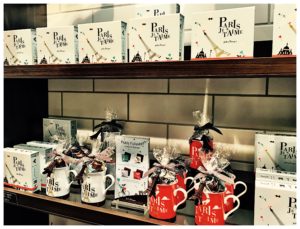 So, what’s the appeal of Jeff de Bruges chocolates? In my opinion, it’s the finer details – the attractive and perfectly shaped filled chocolates, the beautifully designed packaging of the boxed chocolates, bars and squares through to the broad variety to meet many a discerning tastes. I see the overall experience as a means to rekindle fond memories of European gastronomic adventures and perpetuate one’s holiday. The products are competitively priced against offerings from local renowned chocolatiers, which is an added bonus. The flavour combinations that I’ve tasted, while good, are not the most exciting that I’ve experienced in Sydney. However, I will reserve my final judgement as I’ve just been invited back for a tasting of Jeff de Bruges’ finest chocolates! I may also give the acclaimed ice cream a go, when the weather warms up.
So, what’s the appeal of Jeff de Bruges chocolates? In my opinion, it’s the finer details – the attractive and perfectly shaped filled chocolates, the beautifully designed packaging of the boxed chocolates, bars and squares through to the broad variety to meet many a discerning tastes. I see the overall experience as a means to rekindle fond memories of European gastronomic adventures and perpetuate one’s holiday. The products are competitively priced against offerings from local renowned chocolatiers, which is an added bonus. The flavour combinations that I’ve tasted, while good, are not the most exciting that I’ve experienced in Sydney. However, I will reserve my final judgement as I’ve just been invited back for a tasting of Jeff de Bruges’ finest chocolates! I may also give the acclaimed ice cream a go, when the weather warms up.